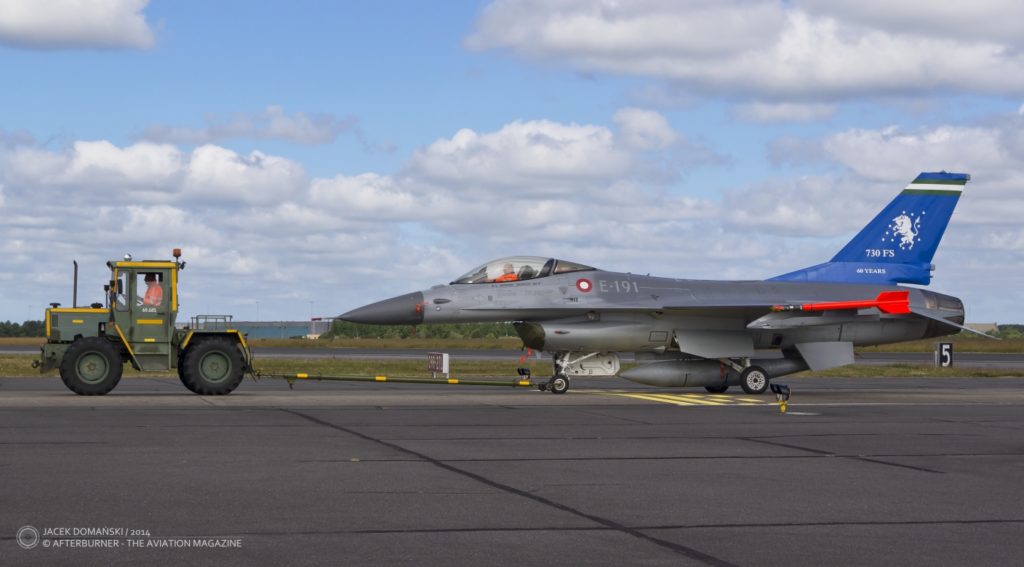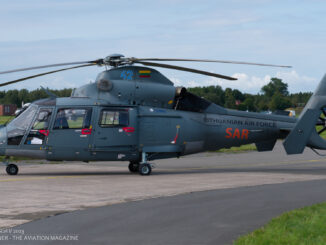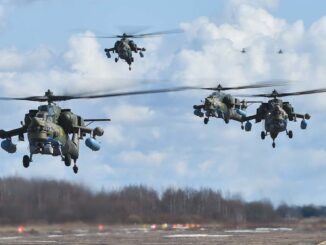 The F-16 Fighting Falcon, commonly also known as Viper, have already appeared in several reports and articles published on our pages. Nevertheless, that aircraft holds a special place in aviation history, and we are far away from having completely explored the topic. This time, using the occasion of generational change that just began in Denmark, we would like to focus on operational service history of that combat aircraft with Flyvevåbnet – the Royal Danish Air Force (RDAF)
The F-16 Fighting Falcon, commonly also known as Viper, have already appeared in several reports and articles published on our pages. Nevertheless, that aircraft holds a special place in aviation history, and we are far away from having completely explored the topic. This time, using the occasion of generational change that just began in Denmark, we would like to focus on operational service history of that combat aircraft with Flyvevåbnet – the Royal Danish Air Force (RDAF)
It all started in the early 1970s, when four NATO countries – Denmark, Belgium, the Netherlands and Norway, started searching for modern combat aircraft to succeed its fleet of fighter aeroplanes. At that time, the RDAF inventory was quite diverse and included F-104G Starfighter, North American F-100D/F Super Sabre and Saab J 35 Draken fighters.
There were three potential candidates that competed for the new combat aeroplane for the mentioned countries – Dassault Mirage F-1 from France, Saab J-37 Viggen from Sweden and the F-16 Fighting Falcon from the United States. And it was exactly the latter aircraft, manufactured at that time by General Dynamics, that was chosen by the four countries as their new basic fighter.
In 1975, Denmark, Belgium, the Netherlands and Norway jointly ordered a total of 348 examples of the F-16 aircraft. These countries not only became the first international customers for that aircraft but, through European Participating Air Forces (EPAF) initiative, they also joined a multinational F-16 development programme, led by the United States.
Among the provisions of the programme, there was transfer of technologies. As a result, all the EPAF aircraft had to be manufactured in Europe, by SABCA in Belgium and by Fokker in the Netherlands. Soon, the Belgian aerospace company became the largest European manufacturer of the F-16 in Europe, building the aircraft for domestic and Danish air forces. The initial Danish order included fifty-eight aircraft (forty-eight single-seat F-16A and ten double-seat F-16B). On 18th January 1980, Flyvevåbnet received its first F-16 Fighting Falcon jet. It was the aircraft of F-16B variant, with serial number ET-204.
In 1984, Denmark ordered further eight examples of F-16A and four F-16B. This time, they were aircraft built by Fokker and were delivered between 1988 and 1989. The second order was followed by yet another, final purchase of six F-16A and one F-16B. Those fighters were former USAF aircraft and were delivered between 1994 and 1997.
In total, Denmark acquired seventy-six F-16 Fighting Falcon fighter jets, sixty-two of which were single-and fifteen were two-seaters. In terms of equipment and upgrades, the Danish fleet included thirty-nine aeroplanes of Block 10 variant and thirty-eight jets of Block 15 version.
Over the years, the Danish F-16s have undergone a number of improvements and upgrades that have enhanced their combat capabilities and extended their service life. In 1986, most of the European countries operating the F-16 aircraft decided to replace their Pratt & Whitney F100 PW200 engines with newer PW-100-220E version generating higher thrust. Denmark, however, initially chose not to introduce this upgrade. In 2013 it became clear that the Danish F-16s would not be able to fly by 2024, the date of their expected retirement from service, still powered with the original engines. Only then, decision was made to purchase fifty used F100 PW220E engines.

However, the largest modernisation that the RDAF Fighting Falcons were subjected to, was the Mid Life Upgrade (MLU) that began in 1989.
Initially, the F-16s were expected to retire in the 1990s, being replaced by new type of fighter aircraft. The end of Cold War and reduction of European armed forces that followed, caused that many countries were not interested in any new military developments, just wanting to keep existing equipment in active service as long as possible. The F-16 Fighting Falcon was no exception, so the EPAF countries joined again in order to execute the MLU programme on their aircraft. The development phase started in 1991 and modernization works began in 1997.
In the meantime, the USA withdrew from the MLU programme. As a result, the modernisation works were done by aviation companies and maintenance workshops of all four European partner nations – SABCA, Fokker, the Royal Norwegian Air Force maintenance unit at Kjeller and the RDAF maintenance unit at Aalborg Air Force Base, in northern Jutland.
The MLU programme involved forty-eight F-16A and thirteen F-16B of the RDAF. Those aircraft were modernized to MLU 6.5 standard. However, seven examples of the older Block 10 variant, that were only used for training and Quick Reaction Alert (QRA) tasks were upgraded to lower, MLU 4.3 standard.
In the late 1990s, alongside implementation of the MLU programme, Denmark began taking its first steps towards searching for a successor to the F-16 aircraft used by its air force. In 2002, the country joined Joint Strike Fighter (JSF) programme, led by Lockheed and focused on development of a 5th generation fighter for USAF and partner nations, such as Australia, Canada, Italy, the Netherlands, Norway and the United Kingdom.
That programme finally led to creation of F-35 Lightning II fighter aircraft. Denmark – however, not without several perturbations on the way – became one of the countries that soon introduced the 5th generation jets into operational service. More details about the Danish way to F-35 Lightning II can be found here, in our article issued on opportunity of handover of the first locally based aircraft to the RDAF.
Nevertheless, it is expected that the Danish F-35s achieve full combat readiness only in 2027. Until then, Flyvevåbnet will still rely on its fleet of about thirty F-16s it currently has in their inventory (according to information as of 2023).
Currently, the F-16s of the RDAF are operated by two units – Eskadrille 727 and Eskadrille 730 (727th and 730th Fighter Squadrons, respectively), the home base of which is Skrydstrup air base.

An interesting fact is that none of those fighters are assigned to each of those units on regular basis. In fact, all of them are part of Aircraft Maintenance Squadron inventory and are allocated to both of the fighter squadrons depending on the operational needs.
Majority of the world’s leading air forces operate their own aerobatic teams or fighter jet solo displays. It is no different in case of Flyvevåbnet that is proud to have the RDAF F-16 Solo Display as its global showcase. What’s more, the Danish jet display is unique in a number of ways.
First of all, unlike the majority of air forces that known worldwide for their F-16 solo displays, Flyvevåbnet does not have a specific pilot or even a particular aircraft assigned to perform displays in a given season.
In fact, the RDAF F-16 Solo Display includes up to three pilots from the two units mentioned above. Each of them is trained and licensed to perform several displays during the season. Certainly, there is a justification for that procedure. The reason is they are all active service military pilots, for whom display training and then performing at air shows is only an addition to their main duties. And having up to three display pilots helps to reduce the operational workload of the units. Moreover, it is actually up to the pilots themselves how long they would like to act as the RDAF demonstration pilots.
No less interesting is the case of the RDAF F-16 Solo Display aircraft. The long-term tradition is that a few months before a particular air show season, one of the aircraft from the inventory of the 727th and 730th Squadrons is being selected. Then, the pilot assigned for the show, begins intensive training on that particular F-16 and then performs the actual display.
Despite the unusual flexibility and rotation among the team’s pilots and aircraft, they do not change that often. For the last few seasons until 2023, the Danish solo display aircraft was a Belgian-manufactured SABCA F-16AM, with serial number 6F-18 and side number ‘E-191’.
History of that aircraft is every bit as interesting. It was built as the F-16A Block 10 and then handed over to Flyvevåbnet on 22nd May 1981. Three days later, the aeroplane was officially integrated into Eskadrille 730.
In September 1985 the ´E-191´ received a special tail art to commemorate 40 years of Esk 730. In the following years, similarly to other operational Danish F-16s, the aircraft underwent the aforementioned Mid Life Upgrade that modernized it to the Block 20 MLU standard. In 2006, that F-16 was reassigned to 727th Squadron but returned to Eskadrille 730 after only two years. In 2011, the ´E-191´, together with several other F-16s of the RDAF, participated in Baltic Air Policing patrolling the airspace of Lithuania, Latvia and Estonia, alongside aircraft of Luftwaffe and Armée de l’Air.

Three years later, the aircraft received another special tail art painting, this time commemorating the 60th anniversary of the 730th Squadron. The livery was disclosed to general public in June of 2014, during the biennial Danish Air Show held at Karup air base. The aircraft was then reassigned to Eskadrille 727 and belongs to this unit to this day.
In 2019, being already assigned to the display duties, this F-16AM received a very special colour scheme, commemorating the 800th anniversary of Dannebrog (English: Danish national flag), commonly considered the oldest national flag in the world. Shortly after receiving that exceptional livery, the ´E-191´ toured Denmark to celebrate the abovementioned anniversary of the Danish national symbol. Over the following years, the aeroplane took part in a number of air shows and similar events in Denmark and Europe.
The year 2023 was the final display season for the ´E-191´. The RDAF F-16 Solo Display scheduled only five public performances for the season, starting with Turku Airshow (Finland), followed by RIAT (UK) and then Roskilde (Denmark).
On the last weekend of August 2023, the RDAF F-16 Solo Display visited Poland and took part in the International Air Show in Radom. That was the only second time since 2005, when the Danish F-16s visited this country for an air show. During both days of the event, Danneborg was flown by Captain Troels ‘TEO’ Vang who delighted tens of thousands of the air show visitors with his great and dynamic flying display. Without any doubts, the Danish display was one of the highlights of the Radom air show.
Finally, at the beginning of September 2023, during the Athens Flying Week, the RDAF F-16 Solo Display performed its last, but no less amazing, display with Dannebrog.
On 12th October 2023, the F-16AM Block 20 ´E-191´ made its last flight in Dannebrog livery. According to the official social media channels of the RDAF F-16 Solo Display, it was the flight from Skrydstrup air base to maintenance workshop in Aalborg, where the aeroplane will soon receive the standard grey livery of Flyvevåbnet. While leaving its home base, the ´E-191´ performed a joint flypast over Skrydstrup airfield, together with the RDAF F-35 Lightning II.
Nevertheless, the RDAF F-16 Solo Display ensures that end of display duties for Dannebrog does not mean the end of the team activities. As they disclosed in the social media, the RDAF F-16 Solo Display is going to continue their display venture in next years.
However, the days of the Danish F-16s are already counted and their replacement by the F-35 has already started. It is clear that number of Fighting Falcons in active service with Flyvevåbnet will be gradually decreasing. Therefore, the question arises if we will still have an opportunity yet to see another special livery on the RDAF F-16 display aircraft, so amazingly great as Dannebrog was. Well, we can only hope so…




